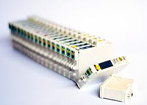While revolutionary new inkjet printing technology from Silverbrook Research has set the printer industry abuzz, few outsiders have been permitted to closely examine the print quality of the prototypes.
Can $200 inkjet printers working at more than twice the speed of anything else on the market actually print clearly, without smudging the ink? And even if this breakthrough technology really works, how can a tiny company like Silverbrook survive in an industry dominated by giants like HP, Canon and Epson?
Update Mar 21: Silverbrook has now officially announced the Memjet printing technology. See our latest article for a new high-quality video, and news on when products are expected to become available, plus a surprising price comparison with HP's innovative new Edgeline printers - the only inkjets that might offer similar speeds to Silverbrook's claims for Memjet.
Please refer to our earlier articles if you require more background information on this story, 1, 2.
Early print quality 'satisfactory'
“The print quality I've seen so far I would say is satisfactory, in general,” says Steve Hoffenberg of Lyra Research, who was allowed to examine prototypes at Silverbrook's labs recently.
“Although its not as good as some of the best ones I've seen out there,” he says, “what I've seen so far has been from prototype print heads that weren't fully calibrated and early versions of the firmware.”
“It's clear that the print quality already is good enough that we don't anticipate there'll be any problem getting to the real production level that will be required for these products to come to market.”
Despite the unprecedentedly high speed, the printer is in many ways much simpler than existing technology. “The pagewidth printhead gives very precise registration, there are fewer mechanical problems with the paper moving,” says Hoffenberg.
Photo Printing deal announced
One of the world's largest operators of photo kiosks, Photo-Me International, will begin rolling out kiosks with Memjet printers at selected locations this summer. From the standpoint of a shop using the kiosk to print customers' digital photos, “the prints look very saleable,” comments printing industry consultant Jerry Lansky, who had a chance to examine the technology behind closed doors earlier this month.
“Memjet is the first inkjet technology that delivers the speed and low cost to meet our product requirements,” Photo-Me Vice President Nicolas Series says, “This technology will allow us to develop new categories of Photo-Me photo kiosks.”
The current roll out is a market trial, according to Photo-Me, but if all goes well, the company already has plans to introduce the kiosks throughout Europe, the US, and Japan
Desktop photos at 30 prints per minute
Lyra's Steve Hoffenberg has seen the desktop version of the same photo printing engine that Photo-Me will use in its kiosks, he also is impressed.
“In the photo print side, the photo printer uses micro-porous photo paper, and the prints are basically dry the instant they come out of the printer. We couldn't smudge them even if we pulled them straight out of the printer,” Hoffenberg comments.
“And with 1600dpi resolution, you can imagine theres tremendous sharpness,” he continues, “we've seen examples of text output on photo paper from these printers that are so tiny that we literally needed a magnifying loupe to be able to see the text, and it still appeared to be in perfect registration. The text output is incredibly sharp.”
When printing on lower quality paper, it was possible, with great effort, to smudge the ink, Hoffenberg says, “but it's not overly susceptible and over time we anticipate that they, like other inkjet manufacturers will continue to improve in that respect.”
Threat from HP, Canon and Epson
Inventing a new printer is only half the battle for Silverbrook. The inkjet printer market is controlled by a handful of mammoth companies, with huge patent portfolios covering printing technology, and legal teams poised to defend them.
“People are wondering, what about the intellectual property rights, because everybody in this business has seen lawsuit after lawsuit, and thinks that HP and Canon have that all locked up,” says Charles LeCompte, president of Lyra Research.
How can Silverbrook, which has only 300 employees, compete with these giants?
“I'm not a lawyer, but Silverbrook already has a huge number of patents on this technology,” points out Steve Hoffenberg.
Silverbrook's war chest of over 1400 patents might actually force other companies to borrow ideas from the Australian firm, Hoffenberg suggests.
“From discussions that we've had with Kia Silverbrook, it seems feasible that in order for other companies to develop some pagewidth array technology they might even be in the position where they have to license technology from Silverbrook... if they want to go down to a micro scale the way Silverbrook has already done.”
This patent portfolio also may allow Silverbrook to offer a larger competitor a cross-licensing deal if it is challenged.
HP's Edgeline: The old new thing?
Silverbrook's Memjet will not be the first high speed pagewidth inkjet printer on the market. That honor goes to HP's Edgeline printers.
“This patented technology will redefine business printing with the combined benefits of ink and laser in a single device: fast printing speeds, excellent print quality for text and graphics, a low cost per page and HP world-class reliability,” HP boasts in its introduction to the technology.
The key selling point of Edgeline is its high printing speed, judging from HP's promotional materials, but the prototype Memjet printers make it look lethargic.
“The print speed of Memjet printers is about two times as fast as the Edgeline printers we've seen so far,” points out Hoffenberg.
Silverbrook's prototype Memjet photo printer churns out color snapshots at a rate of one every two seconds, he says. HP's professional Edgeline photo kiosk and Microlab systems take about 5 to 6 seconds to do the same job.
HP has promised that Edgeline can be ramped up to as much as 60 pages per minute, but Silverbrook has claimed that its technology can reach 120 pages per minute.
“Speed isn't necessarily everything and it varies from market to market the extent to which speed is important,” cautions Hoffenberg, “but clearly that's an area that really stands out from what Silverbrook has done with the Memjet technology. It's just incredibly fast, and that in itself is remarkable.”
However, HP's Edgeline technology, while not currently aimed at the desktop market, is already available, the company says. It is being used in photo kiosks.
Although Silverbrook has shown breathtaking demonstrations of Memjet, the company is not able to make printers itself, so must license the technology to manufacturers, according to Lyra. Silverbrook has not yet explained who will turn the technology into real products.
This question may be answered in less than 24 hours. Silverbrook's founder and CEO, Kia Silverbrook is due to officially announce the Memjet technology on March 21, and is expected to provide more details of his company's plans then.









